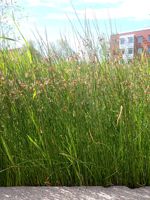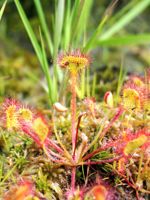Mon-Fri 9am - 5pm Mountain time
Baltic Rush vs Round-Leaved Sundew
Juncus balticus
Drosera rotundifolia
CUSTOM GROW
CUSTOM GROW
Baltic Rush is a widespread native perennial rush that forms dense clumps of upright, cylindrical stems. Well adapted to saturated soils, it is common in wetlands, streambanks, and riparian zones, and is tolerant of both fresh and saline conditions. Hardy and low-maintenance, Baltic Rush contributes to soil stabilization and enhances wetland habitats.
It offers cover for small animals, nesting habitat for birds, and limited forage for livestock when young and tender. Its dense growth and rhizome networks add structural diversity that supports wetland ecosystems, making it well-suited for riparian planting, shoreline stabilization, wetland restoration, and reclamation projects.
Round-Leaved Sundew is a native carnivorous plant, easily recognized by its bright green leaves covered in distinctive red, glandular hairs. These hairs secrete a sticky substance that is used to attract, trap, and digest insects. Their carnivorous nature allows them to survive in nutrient-poor, acidic soils where many other plants may struggle to grow.
They produce small white flowers that grow along the top of a slender, leafless stem. They can be found growing in wetlands, most often among sphagnum moss, in consistently moist, acidic soils. It does best in cooler summer climates and is intolerant of shade. Due to its small size, the plant can be difficult to spot in its natural habitat. Round-Leaved Sundew is an indicator of healthy wetland systems and is valued in ecological restoration and conservation projects.

